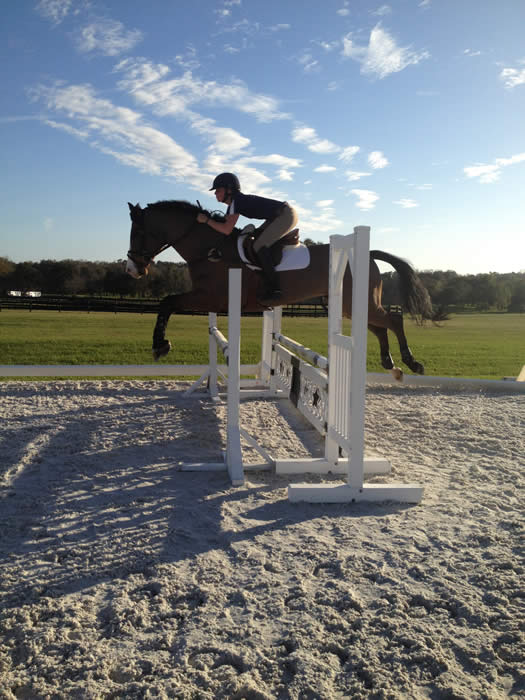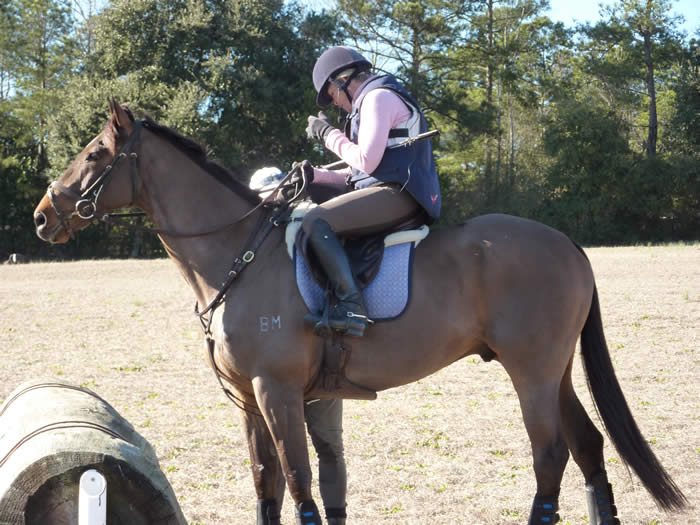The sessions were held January 27 to February 1 at Meredyth South in Ocala, Florida. Right off the bat I’d like to thank our host Jacqueline Mars, and also Colby Blazas of SmartPak and Jennifer Holmes of Toklat for sponsoring us.
There were ten riders plus me auditing because just prior to the training sessions, I had sold my mare, Ever So Lucky, and purchased a young horse that’s not at the two-star level. I had a great opportunity to sell my horse in the barn to a young rider looking for experience at the one- and two-star level, thought was great time to do it and frankly couldn’t afford a new horse without selling her. I’m really excited for myself, excited for Chase (her new owner), but of course have mixed emotions as "Bagel” had taught me so much.
The training sessions were a mixture of lectures and riding. In both, David emphasized the basics, reminding us that you can get away with things for a while, but invariably, it’s your day and then the holes will show up. He talked about how we learn sports and related riding to other sports, emphasizing studying in the classroom first so we have a good grasp on what should be doing. He went into a lot of detail about our aids—voice, legs, seat, body weight and hands.
He then broke up the aids to explain what they should be used for, and was adamant about the importance of being consistent so the horse knows what you want. For instance, he defined the seat as being from below the rib cage to our knee, and how it’s used to influence the trot: up and down for more energy and more forward, how an open seat moves with the horse’s back, how seat is more important than leg and hand. He spoke about pressure on and off, release as the reward, and how we teach our horses to ignore us because we’re using our aids incorrectly.
David’s teaching method involved asking us a lot of questions, but we were also able to ask him questions. He did things like have us stand and move our bodies to learn lateral work.
Another big emphasis of his teaching was learning to place the horse’s feet and to recognize that if they’re hard on one side or stiff in the bridle, it often means their feet are wrong. Knowing where the horse’s feet are relates to accuracy and knowing where their feet are in the ring. Because horses tend to step out of a circle, he used tennis balls in a 20-meter circle on the ground as a visual for riders to always know where the horse’s feet were. He also outlined two ten-meter circles and had riders stay straight on the centerline, which is hard to do when the circles get smaller! It was amazing how much more accurate people were by the end of the week.
In addition, David insisted that the riders knew ring geometry and where circles and movements should fall. He stressed always looking a quarter circle ahead, and before the center line, looking a quarter of the way around your ten-meter turn to avoid cutting in.
The riders rode in groups of three or four on the flat, which forced them to be much more aware of their horse’s tempo. Even if some horses were hot the first day, but the end of the lesson they all looked pretty much the same. It was interesting how people who looked down at their horse’s head were always behind because they were concentrating on their horse and not the other riders. Once again, David related this back to always thinking ahead when riding a test. He also had riders work on lots of forward and back created purely from the hip, keeping the horse on circle or line, and not drifting on the diagonal by putting the horse’s nose at the letter and turning with the hip.
The next morning we had a lecture on jumping and rider responsibilities and position. David emphasized that further than five strides out, the rider is responsible for direction, speed, rhythm, balance and timing; these should be done and you should only be reacting to the distance and timing after that. Riders need to be able to recognize a distance no matter what canter they’re in. David used gymnastic exercises to make his points. He had the riders come to a wide oxer and told them not to point their horse’s nose at jump, not commit to the distance because there’s usually one more stride, and to use the rein to bring the horse’s shoulder around.
We also had a lecture on course design, and building different shape jumps and how horses jump the different shapes. David described different warm-ups and how every jump counts, and the importance of knowing what type of jump benefits your horse.
In the next lecture David talked about the six things he feels are needed to get to top in Eventing, listed in this order: ambition, intelligence/emotional control, technique, selecting appropriate horses, horse/time management and talent.
The third day was a flat day and riders worked on drills and test movements. David went into specifics about recognizing where a horse should be in the movements, for instance, being really aware of where the half pass starts and finishes.
The fourth day we all helped to set a course in morning, and then we walked it without consulting with each other. After, David had riders talked about their plan for their horses. He stressed that, when time allows, you travel along. He talked about always having a plan when you land, having your canter done five or six strides from the jump, using the gaps to get that canter back, knowing where you are in a line and depending on the type of jump, understanding where your horse will land. The riders worked on seven or eight strides to combination, which is just enough time to panic! He had them test riding the number of strides, to know the canter they needed.
The next lecture we heard from Joe from KER about equine nutrition. He emphasized that owners often overuse supplements and that they can overload or cross each other out, so we really need to know how to read labels.
On the fifth day everyone had a private lesson with David. The riders warmed up on their own and then ran through a test with David scoring. Afterwards, they talked about what could be improved. It’s amazing how many points are thrown away because of lack of accuracy! The riders were mostly able to put all the tools they’d gained during week into their tests. David had riders go through the three- and two-star test movement by movement, simplifying the movements for them.
That night we had a lecture by a farrier and learned how to take off and put back on a shoe, which is handy to know. I’ll have to practice!
The last day was cross-country day. David put cones out by a small jump. He marked each stride to five strides out and used these to demonstrate how we lose time setting up for jumps. The exercise was designed to remind riders to be efficient. We had a lecture on the reasons we would change speed cross-country: fence type, terrain and lighting. He talked about rider position for galloping, preparation and jumping, and how you prepare depends somewhat on body type. He recommended galloping like a jockey, which is more aerodynamic.
The day ended with the riders going up and down two mounds, and we watched for how their hips moved with the bank. Coming down the hips come forward, but the shoulders should stay the same. The final exercise was up a bank that had a bounce in the middle for footwork. We watched the riders’ position and how their hips moved. As they dropped off the bank, it was fascinating to watch riders keep their shoulders still and move their hips—you could really see a difference in how the horses jumped down. I particularly noticed with Meghan and Pirate.
After the training session, I was able to ride my young horse, RF Cameron Velvet, with David. We worked in the canter, leg yielding off the track a couple steps and back, because he wanted to keep stepping out and the leg yielding kept his out side hind straight. We also worked on large turns-on-the-forehand and haunches to keep him moving his feet and stepping under with his inside hind. Jumping, we worked a bit on bringing his outside shoulder around, getting to a little deeper spot, and on adding and leaving out strides in lines for adjustability. We also worked on getting him to always look up and look ahead, and on tight rollbacks.
Over the week, I feel as though David inspired all of us and gave everyone the desire to be the best. Huge thanks to Joanie Morris, David’s right hand, go-to person and session organizer. I really enjoyed the group of riders, and think having David as coach will help the whole Eventing community become better, more educated riders and horsemen.


 RSS Feed
RSS Feed